An African grass that is more drought-tolerant than crops such as corn and wheat, sorghum is a staple grain for 500 million people worldwide. In the United States however, sorghum is grown and used primarily as for animal feed.
Using the whole genome shotgun approach, sorghum was the second grass genome to be sequenced after rice. The draft sequence of sorghum was made available in 2007 and the complete genome was published in 2009. Researchers intend to use the genomic information to develop better food and feedstocks, but to also produce strains that are specifically suited for biofuel production. Compared to corn, sorghum uses a third less water than corn to produce the same amount of ethanol per bushel and is the second most prevalent biofuels crop in the United States.
A model for tropical grasses, especially its relatives corn and sugarcane, which have more complex genomes, sorghum’s genetic data will be used to lend insight into other plant genomes that could be used as biofuel feedstocks. Researchers are interested in resequencing sorghum using new sequencing technologies to expedite the use of the sorghum genome in developing biofuel feedstocks and improving agricultural varieties available.
Principal Investigators: Andrew Paterson, University of Georgia
Program: CSP 2010
